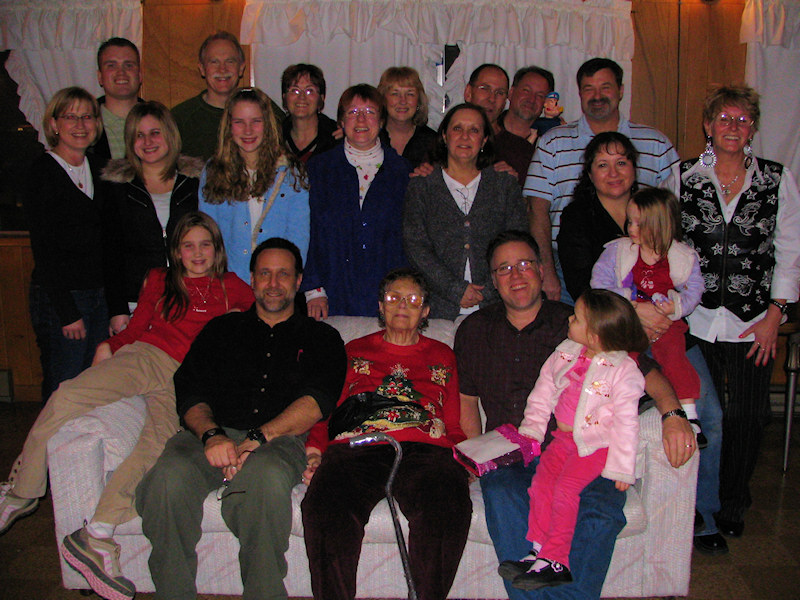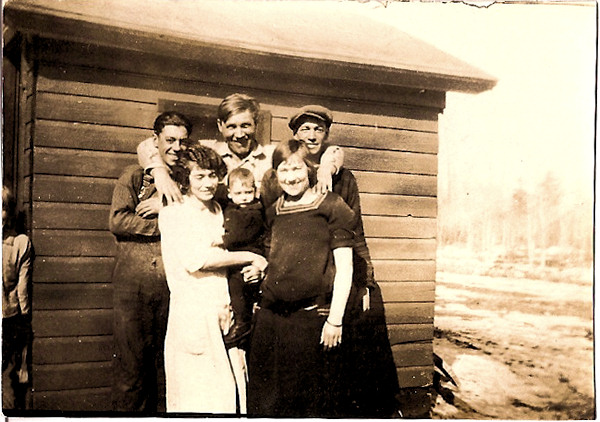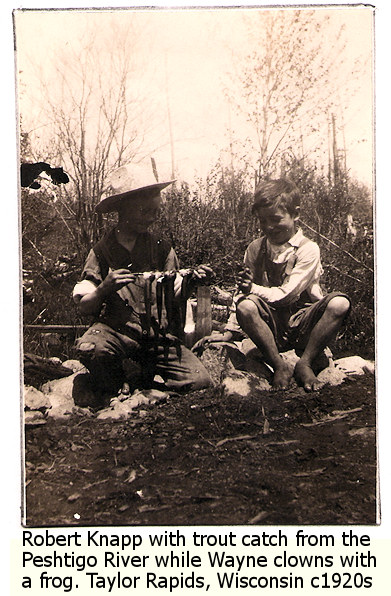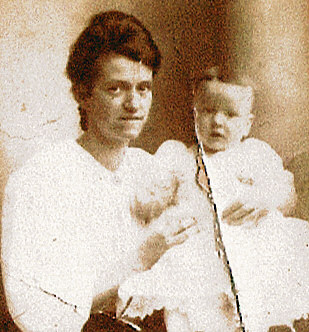According to the History of Riley, Illinois, of McHenry County, my ancestor, Ezra O. Knapp was the first white child born within the township of Riley, son of Charles Sidney Knapp and Laura White, from our Nicholas Knapp Descendents and family tree.
Erza Knapp was born in 1838 and died in 1916 in Marengo, McHenry, Illinois. He was the third child of eleven children and the one year older brother of James Acy Knapp, father of James Asa Knapp, who married Emma Beatrice Primley and had Nora Knapp, who married Raymond Anderson, who gave birth to my mother, and then I came along eventually.
The 1877 McHenry County directory for Marengo Township and Riley Township lists Ezra as:
KNAPP, EZRA O., Butcher, Marengo; born in Marengo January 8,1838; owns 31 acres of land, one mile from Marengo; value of property, $3,500; was a member of the Ninety-fifth Ill. Vol. Inf., under Col. Avery; was in twenty-one battles and at the siege of Vickburg; was Brigade Butcher one year. Married Elizabeth Wise, April 28, 1861; had four children- Hearma A., born July 19, 1866; Ezra O., born December 18, 1870, died January 24, 1871; George H., born March 1, 1873, and Laura S., born April 4, 1876.
Ezra O. Knapp died April 25, 1916, and is listed as buried as a war hero in the Marengo Cemetery near Riley.
According to the Descendants Of Knapp on Rowte’s Genealogy Pages, Ezra O. Knapp may have been named for Ezra Knapp (1724-?), among the fourth generation of Knapps born in the new world and married to Sarah Adams. The family moved from Connecticut to Illinois in the early 1800s, and the senior Ezra Knapp might have been an influential old man or well remembered. Ezra named his son, Ezra O. as well. Ezra was also a popular biblical name at the time.
It’s clear from the records that other than the Civil War, Ezra rarely strayed from his birthplace of Riley and the neighboring town of Marengo, Illinois, where he became a respected member and long lasting pioneer family of the area.
Riley and Marengo, Illinois
The book, History of Riley, Illinois, of McHenry County, published by Munsell Publishing Company in 1922, available online, talks about Riley Township as a town in the southwestern part of McHenry County in Illinois known for its agriculture. Once a vast prairie land, “the farms were spoken of as being among the best in Northern Illinois.”
Founded by T.W. Cobb, Roswell Bates, N.E. Barnes, Jenikins Underwood, and Osborn Underwood between 1836 and 1843, Ezra’s family shows in the records as appearing just before his birth in 1838 among the pioneering families, and staying there permanently, with Esra raising his own family there and in Marengo close by.
It was said of this township in 1877: ‘Having plenty of facilities in adjoining townships, they have erected no church buildings within its limits. The population for many years was evenly divided between the Congregationalists and the Methodists. Meetings were frequently held in nearby schoolhouses.’
From the start, this township has been alive to the value of a good common school system and has improved every opportunity given it along this line.
The township was among, if not the very first in the county to provide itself with a good town hall, centrally located, where it held its elections and transacted all business, while other townships put up with tile schoolhouse that happened to be situated nearest by for all such affairs.
It had a cheese factory in the early seventies [1870s]. It also was early among the townships of the county to set out fruit trees and reaped the reward of such action by later harvesting large crops of luscious apples and cherries.
In 1890, Riley Township had a population of 830, and grew to 915 in 1900. Even today, Riley, Illinois, is considered too small to even count for the census, and is called an “unincorporated hamlet” served by the larger Marengo nearby, where Ezra died.
The Civil War
During the Civil War, Ezra signed up for the Company E 95th Illinois Infantry in Marengo, September 5, 1862, at age of 30, followed by his brother, Justus, on November 28, 1863. Justus was transferred to Company E of the 47th Illinois Infantry, and Ezra mustered out August 17, 1865.
In the History of 95th Illinois Regiment, it tells of how the 95th Illinois Infantry was under General McArthur’s Division, Army of the Tennessee, and how it took part in the turn of the eary in General Grant’s campaign in Northern Mississippi in the winter of 1862.
After the capture of Holly Springs by General Van Dorn, General Grant’s Army took up its line of march for Memphis, starting soon after Christmas. The Ninety-fifth arrived at Moscow, a small town between LaGrange and Memphis, December 30. On the 1st day of January, 1863, it resumed the march, and on the 2d arrived at Collierville. Colonel Deitzler’s Brigade, to which the Ninety-fifth was assigned. It was ordered to halt here a few days prior to advancing on Memphis, during which time the regiments were mainly occupied in repair ing and guarding the railroad. While remaining at this place the regiments were required to be up and in line of battle at 3 o’clock a. m. for several mornings in succession, watching for the enemy until daylight. The disaster which had occurred at Holly Springs made all commanders more watchful. On the 13th of January the Brigade moved forward to Memphis, arriving there in the afternoon, and went into camp three miles out from the city. The campaign thus closed in Northern Mississippi.
Simultaneously with the presence of General Grant’s Army at Memphis a large fleet of transports was also collected at that point for the purpose of conveying the troops down the Mississippi river to operate against Vicksburg. These were ready by the 19th of January for the reception of General McArthur’s Division, which was now designated as the Sixth Division of the Seventeenth Army Corps, commanded by Major General James B. McPherson. On that day the Ninety-fifth embarked upon the steamer Marie Denning… they participated in the march to Grand Gulf, and all the battles between that place and the rear of Vicksburg. Was in the charges of May 19, before Vicksburg, A charge was ordered along our whole lines upon the enemy’s works to take place at 2 o’clock in the afternoon, and at the appointed hour the furious onset commenced. General Sherman’s Fifteenth Army Corps occupied the right of the federal line resting on the river above Vicksburg, General McPherson’s Seventeenth Army Corp held the center and the Thirteenth Corps. under General McClernand, held the left, extending nearly to the river on the south side of the city. The ground in front of General Ransom’s Brigade and over which it charged at the time was located near the Jackson road on the right of the celebrated “White House” and near Fort Hill. The Ninety-fifth held an important position in the Brigade during this charge. While maintaining this position Colonel Humphrey received a congratulatory dispatch from General Ransom. In this assault Colonel Humphrey received, early in the action, a wound in the foot, but remained with his command cheering on his men until he received orders to withdraw his Regiment, under the cover of darkness, from this attack. The Ninety-fifth lost in this engagement 7 killed and 54 wounded.
General Grant ordered the assault to be renewed on the 22d of May, and at 10 o’clock A, M., a furious charge began. The Ninety-fifth gained an advance position on the crest of the ridge near the enemy’s works encountering one of the most sweeping and destructive fires to which troops were ever exposed. Captain Manzer, of Company C, and Captain Cornwell, of Company K, were killed; Major William Avery, Captain Cook, of Company D, Lieutenant Smith, of Company C, Lieutenant Sponable, of Company A, and Lieutenant Pierce, of Company I, were severely wounded, The total killed, wounded and missing in these two charges was 25 killed, 124 wounded and 10 missing.
After the unsuccessful charges of the 19th and 22d of May, the great siege began and was prosecuted vigorously all through the sultry days of May and June, and on the 4th of July, the Ninety-fifth was among the first regiments to enter the city.
On the 12th of July, General Ransom’s Brigade was ordered to proceed to Natchez for the purpose of occupying that point. It arrived there on the following day and affected a landing without opposition. The Brigade remained at Natchez until the middle of October. While the Ninety-fifth was in camp at this place General McArthur commanding the Division, paid the troops a visit and on invitation of Colonel Humphrey attended a dress parade of the Ninety-fifth. The General expressed himself greatly pleased with the appearance of the Regiment and he and his staff joined in the opinion that they had never witnessed a more perfect dress parade during the service.
The Ninety-fifth stayed in Vicksburg, Virginia, under the command of Brigadier General Thomas K. Smith through the fall and winter of 1863 to build and reinforce the garrison. Ezra Knapp mustered out in November after seeing more than his share of the battles. By spring of 1864, the 95th Illinois Infantry men were almost wiped out with few survivors after furious battles across the south.
According to records from the Montgomery, Alabama, headquarters in August 1865, the remaining enlisted men of the 95th Illinois Volunteer Infantry were transferred to the 47th Illinois Volunteer Infantry, which included Ezra’s brother, Justus, who had stayed in through the worst of the battles after Ezra mustered out.
The 1877 McHenry County Directory recognizes Ezra O. Knapp as an honored veteran for his service in the Civil War.
After the horrors of war, it appears as if Ezra O. Knapp stayed close to his birthplace and family roots working as a butcher and farmer. He raised his four children, of which three survived, in Riley Township and Marengo, Illinois, with his wife, Elizabeth Wise.
If you have any photographs or more information on Ezra O. Knapp, we’d love to hear from you.
Most Recent Articles by Lorelle VanFossen
- The Myths and Mysteries and Hunt for Nicholas Knapp
- The Perpetual Calendar
- GenSmarts: Reminder to Not Assume
- Gensmarts Saves Your Family History Research Life
- Digging Through Historical Newspapers Online






Pingback: Lorelle’s World as of May 21st, 2011